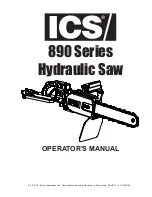
18
tightening the screw. If the screw to secure the vise arm
contacts the guide fence, install the screw on the opposite
side of vise arm. Make sure that no part of the tool
contacts the vise when lowering the handle fully and
pulling or pushing the carriage all the way. If some part
contacts the vise, re-position the vise.
Press the workpiece flat against the guide fence and the
turn base. Position the workpiece at the desired cutting
position and secure it firmly by tightening the vise knob.
WARNING:
•
The workpiece must be secured firmly against the
turn base and guide fence with the vise during all
operations.
If the workpiece is not properly secured
against the fence the material may move during the
cutting operation causing possible damage to the
blade, causing the material to be thrown and loss of
control resulting in serious personal injury.
Horizontal vise (optional accessory)
(Fig. 37)
The horizontal vise can be installed in two positions on
either the left or right side of the base. When performing
10° or greater miter cuts, install the horizontal vise on the
side opposite the direction in which the turn base is to be
turned.
(Fig. 38)
By flipping the vise nut counterclockwise, the vise is
released, and rapidly moves in and out. To grip the
workpiece, push the vise knob forward until the vise plate
contacts the workpiece and flip the vise nut clockwise.
Then turn the vise knob clockwise to secure the
workpiece.
The maximum width of workpiece which can be secured
by the horizontal vise is 215 mm.
When installing the horizontal vise on the right side of the
base, also use the sub-fence R to secure the workpiece
more firmly. Refer to the “Sub-fence R” section described
on previously for installing the sub-fence R.
WARNING:
•
Always rotate the vise nut clockwise until the
workpiece is properly secured.
If the workpiece is
not properly secured the material may move during the
cutting operation causing possible damage to the
blade, causing the material to be thrown and loss of
control resulting in serious personal injury.
• When cutting a thin workpiece, such as base boards,
against the fence, always use the horizontal vise.
OPERATION
NOTICE:
• Before use, be sure to release the handle from the
lowered position by pulling the stopper pin.
• Do not apply excessive pressure on the handle when
cutting. Too much force may result in overload of the
motor and/or decreased cutting efficiency. Push down
handle with only as much force as is necessary for
smooth cutting and without significant decrease in
blade speed.
• Gently press down the handle to perform the cut. If the
handle is pressed down with force or if lateral force is
applied, the blade will vibrate and leave a mark (saw
mark) in the workpiece and the precision of the cut will
be impaired.
• During a slide cut, gently push the carriage toward the
guide fence without stopping. If the carriage movement
is stopped during the cut, a mark will be left in the
workpiece and the precision of the cut will be impaired.
WARNING:
•
Make sure the blade is not contacting the
workpiece, etc. before the switch is turned on.
Turning the tool on with the blade in contact with the
workpiece may result in kickback and serious personal
injury.
CAUTION:
• Do not release the saw head uncontrolled from the fully
down position. Uncontrolled saw head may hit you and
it will result in personal injury.
1. Press cutting (cutting small workpieces) (Fig. 39)
Workpieces up to 91 mm high and 70 mm wide can be
cut in the following manner.
Push the carriage toward the guide fence fully and
tighten the locking screw clockwise to secure the
carriage. Secure the workpiece correctly with the
proper type of vise. Switch on the tool without the
blade making any contact and wait until the blade
attains full speed before lowering. Then gently lower
the handle to the fully lowered position to cut the
workpiece. When the cut is completed, switch off the
tool and WAIT UNTIL THE BLADE HAS COME TO A
COMPLETE STOP before returning the blade to its
fully elevated position.
WARNING:
•
Firmly tighten the knob clockwise so that the
carriage will not move during operation.
Insufficient
tightening of the knob may cause possible kickback
which may result in serious personal injury.
2. Slide (push) cutting (cutting wide workpieces)
(Fig. 40)
Loosen the locking screw counterclockwise so that the
carriage can slide freely. Secure the workpiece with
the proper type of vise. Pull the carriage toward you
fully. Switch on the tool without the blade making any
contact and wait until the blade attains full speed.
Press the handle down and PUSH THE CARRIAGE
TOWARD THE GUIDE FENCE AND THROUGH THE
WORKPIECE. When the cut is completed, switch off
the tool and WAIT UNTIL THE BLADE HAS COME
TO A COMPLETE STOP before returning the blade to
its fully elevated position.
WARNING:
•
Whenever performing a slide cut, first pull the
carriage full towards you and press the handle all
the way down, then push the carriage toward the
guide fence. Never start the cut with the carriage
not pulled fully toward you.
If you perform the slide
cut without the carriage pulled fully toward you
unexpected kickback may occur and serious personal
injury may result.
•
Never attempt to perform a slide cut by pulling the
carriage towards you.
Pulling the carriage towards
















































